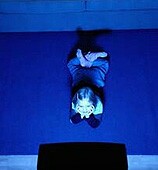
MONDAY, Jan. 11 (HealthDay News) — Movies made for kids are getting better at portraying safety behaviors like wearing seatbelts and bike helmets, but they’re still missing the mark about half the time.
That’s the conclusion of a government study that’s been tracking injury-prevention practices in movies since 1995. The study found that just 56 percent of motor vehicle passengers on the silver screen wore their seatbelts, while a mere 25 percent of people bicycling wore helmets.
“Personal injuries are the leading cause of death in children, but when appropriate safety recommendations are followed, deaths are decreased,” noted study author Jon Eric Tongren, an epidemiologist at the U.S. Centers for Disease Control and Prevention in Atlanta. “If Hollywood can portray health messages that are factual, that would be very important, because children may imitate what they see on film.”
The current study is the third in a series of studies designed to assess how injury-prevention practices are being portrayed in movies targeted to children. The first looked at movies from 1995 to 1997, the second from 1998 to 2002 and the current study looked at movies from 2003 to 2007.
In the latest report, the researchers included the 25 top-grossing films rated either G or PG for each year. They excluded animated films, fantasy films, documentaries and movies not set in the present day. After the exclusions, 67 films were analyzed for scenes with safe or unsafe behaviors.
Five of the movies were rated G, and the remaining 62 were PG-rated. Thirty-eight movies were comedies, 15 were action/adventure movies, 13 were children/family films and one was a drama.
From those movies, the researchers found 958 person-scenes involving potential injury-prevention practices. Fifty-five percent of the scenes involved children.
Twenty-two person-scenes involved either a fall or a crash, but just three of those scenes resulted in an injury.
“In reality, that’s probably not what’s going to happen and the lack of consequences in films may give children a false sense of security,” Tongren said.
Dr. Barbara Gaines, director of the Benedum Pediatric Trauma Program at Children’s Hospital of Pittsburgh, agreed that the lack of consequences in films is a concern. “People are falling, crashing and having these events happen where they don’t have the expected consequences. It’s like when you watch animated cartoons and the character gets smooshed and then pops right back up. It makes me wonder what the impact of that is?” she said.
The study found that 56 percent of people in motor vehicles wore seatbelts; 35 percent of pedestrians used crosswalks; 75 percent of boaters wore life vests and 25 percent of bicyclists wore helmets.
Results of the current study are to be published in the February issue of Pediatrics.
When compared to the previous studies, the researchers did find that cinematic use of seatbelts, life vests, crosswalks and bicycle helmets had all increased.
“The entertainment industry has improved significantly, but Hollywood still has a long way to go,” said Tongren, who added that “parents should take an active role in viewing movies and highlighting unsafe behaviors.”
For example, he said, in a recent movie featuring “Hannah Montana” teen idol Miley Cyrus, her character was shown riding in the back of an SUV with her father — and not wearing a seatbelt. Parents need to point out that’s not the safest behavior.
Gaines said, “If you’re watching a movie with your child and there’s a major scene where someone didn’t buckle up, give your kid a nudge, and say something like, ‘Uh-oh, what did that guy forget to do?'”
As for consequences, she said it’s important to point out to your child that if the same fall or crash were to happen to him or her, the results probably wouldn’t be the same. Say something like, “That person was pretty lucky, you could get really hurt from a fall like that,” Gaines suggested.
She also said that this study highlights the need for parents to prescreen the kinds of movies and TV shows their children might watch, keeping in mind, “Is this really something I want them to watch? Or, are there a lot of messages I don’t want them to take in?”
Tongren said the researchers are hoping that the Motion Picture Association of America (MPAA), the organization that sets movie ratings, will begin to include injury-prevention practices as part of the ratings.
More information
Learn more about preventing injuries in children from the U.S. Centers for Disease Control and Prevention.

